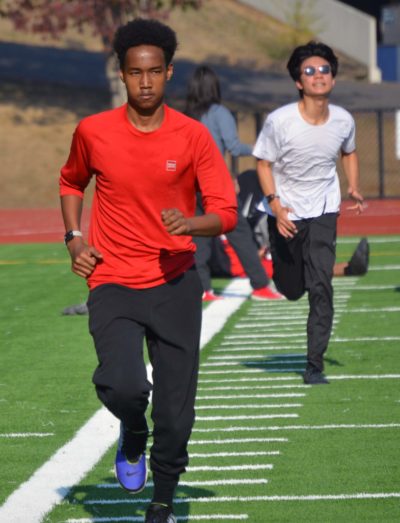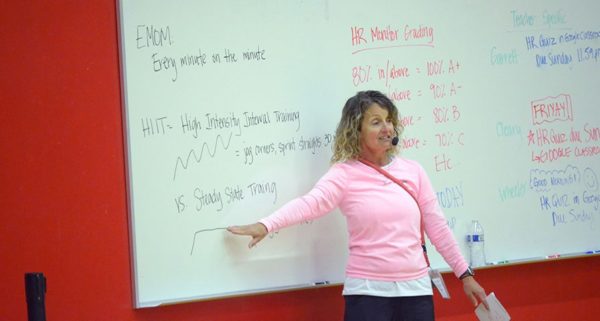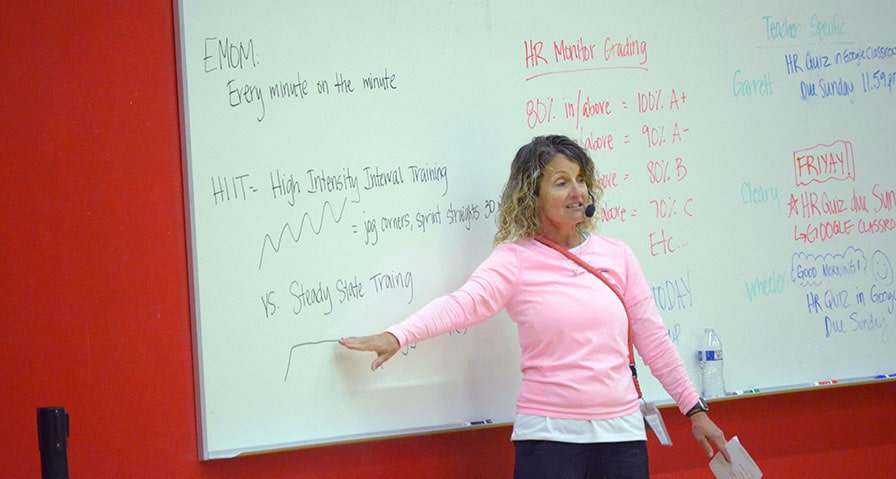Renton School District (Wash.) uses IHT ZONE heart rate monitors to teach high school students to develop fitness concepts that will serve them as adults.
Teri Garrett, a veteran physical education teacher and the district’s secondary PE coordinator, continually works with her colleagues to develop a program that meets state and national standards while empowering students to take charge of their fitness. Each unit focuses on different fitness concepts with the ultimate goal of using technology to help students learn to create detailed individual fitness plans.

Lindbergh High School students exercise wearing the IHT ZONE heart rate monitor during their PE class.
To launch her program, Garrett spearheaded a movement to provide a set of IHT ZONE heart rate monitors for each high school PE teacher across Renton. She’d previously worked with other heart rate monitors but wanted a monitor that didn’t require a constant internet connection to record data.
“When I got to Renton from Seattle (Public Schools), I wanted to find a heart rate monitor that was untethered,” Garrett said. “IHT was the best priced option for us that showed heart rate, color (the monitor shows students their heart rate zone according to color on the screen) and didn’t require a tethering device.”
Heart Rate Monitors that Work Wherever Teachers and Students Need
In a classroom setting, teachers need an internet connection to start and stop the IHT ZONE for students. Once activated though, the IHT ZONE will collect and store heart rate data throughout a class or workout anywhere the teacher – or students – want that workout to take place.
On Fridays, for example, Garrett and her teaching partners put students through a Fitness Friday workout. At Lindbergh High School, students meet in the gym for an active warmup where they can view the day’s activity - and expectation - before they pick up their IHT ZONE heart rate monitors. Once students have their heart rate monitors, they get to work.
Rather than games or sport-specific skill training, the class looks exactly like what you might see from a personal trainer or at a CrossFit, Orange Theory or Camp Gladiator session, including popular "Every Minute on the Minute" (EMOM) workouts.
Weather permitting, Garrett takes students to the school’s turf field and track. With room to work, students get one minute to complete a quick set of exercises – think 20 quick jumping jacks followed by a 30-yard run. The harder they work and the faster they finish, the more time they get to rest before the next set begins.

Teri Garrett goes over the day's plan for PE students at Lindbergh High School before beginning an EMOM workout.
Objective Assessment Based on Each Student’s Data
With as many as 80 students spread out across the field, it’s challenging for Garrett and two colleagues to check on every student. That’s where the heart rate monitors factor in. Before each class, Garrett outlines the workout concept, the specific activities, and the goal for each day – a goal that contributes to the student’s daily grade.
“They know that to get 100% credit for the day, they have to be in their target heart rate zone for 80% of the class that day,” Garrett said. “When they are wearing the heart rate monitor, you can definitely see a difference in the way they work.”
As the 2022-23 school year approached the midway point of the first semester, Renton’s high school students had combined to log more than 30,000 minutes of exercise during class sessions, nearly 19,000 of which have been at a moderate to vigorous level of physical activity (MVPA).
When the workout is complete or class ends, students return the heart rate monitor and the data is automatically transferred into the teacher’s IHT Spirit System account. At that point, both teacher and student see exactly how hard the student worked during class and whether they met the goal.  The system also emails a detailed report to the student (and parent if requested). The report shows students:
The system also emails a detailed report to the student (and parent if requested). The report shows students:
- A graph of their heart rate throughout the session
- Total minutes exercised
- Number of minutes exercising in each heart rate zone
- Number of minutes, compared to that day’s goal, in the target heart rate zone(s)
 The reports give Garrett and the students multiple opportunities for feedback.
The reports give Garrett and the students multiple opportunities for feedback.
- First, students and teacher see the immediate summary – minutes of MVPA achieved compared to the goal – and a quick conversation can take place.
- Second, students can review the email on their own and reply to it with their own insights.
- Third, they can share the information with parents and talk about achievements, fitness skills and other ideas.
Mostly, Garrett said, parents benefit from knowing exactly how their student is faring. Like many other teachers who use IHT ZONE monitors in their programs, Garrett uses the data during conference with parents.
“Heart rate charts are a key part of our parent-teacher conferences,” Garrett said. “We can show parents when students are able to figure things out. Parents like it that kids get that summary email every day.”
Boost Student Wellness with the IHT ZONE heart rate monitor:




